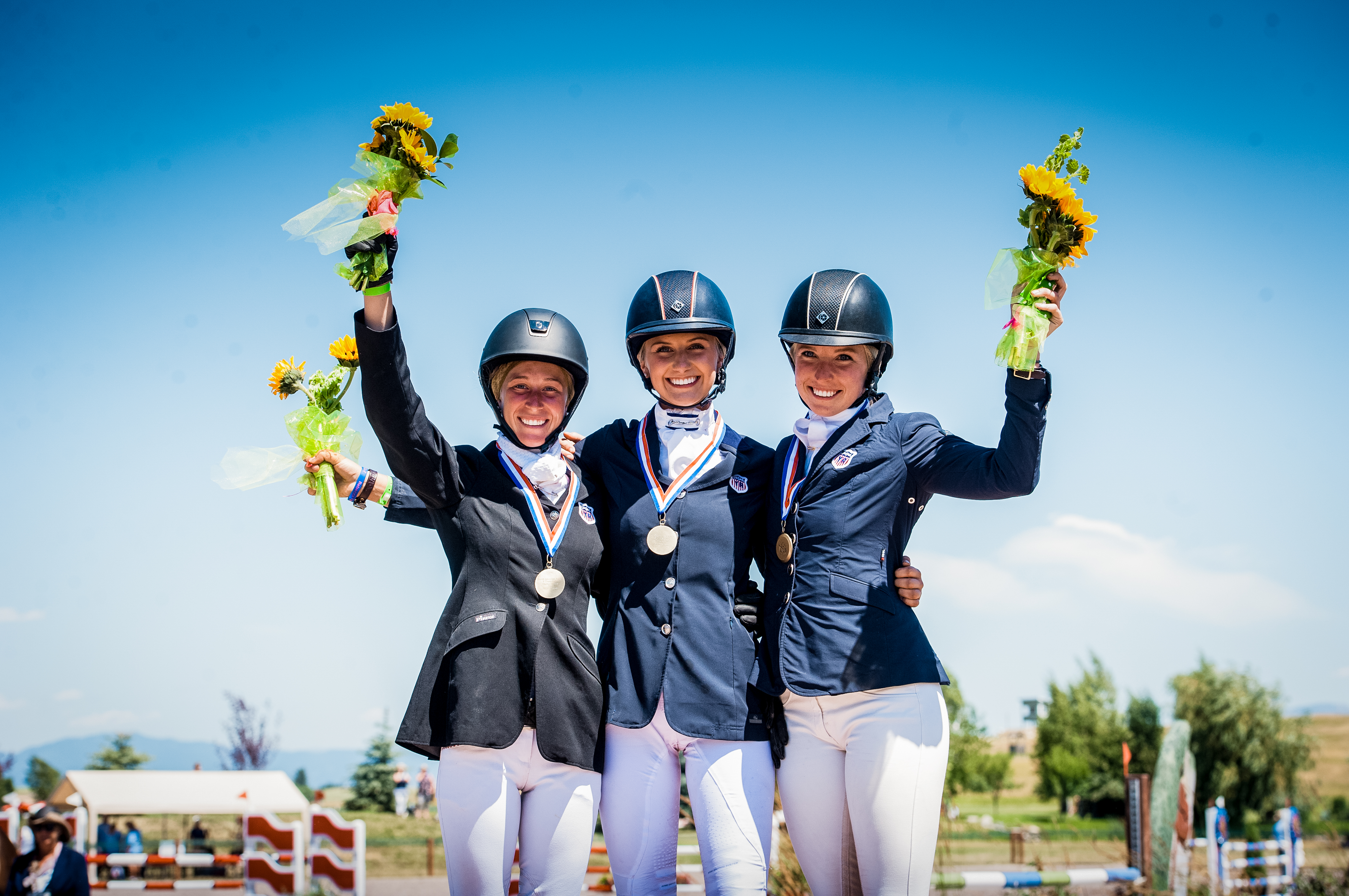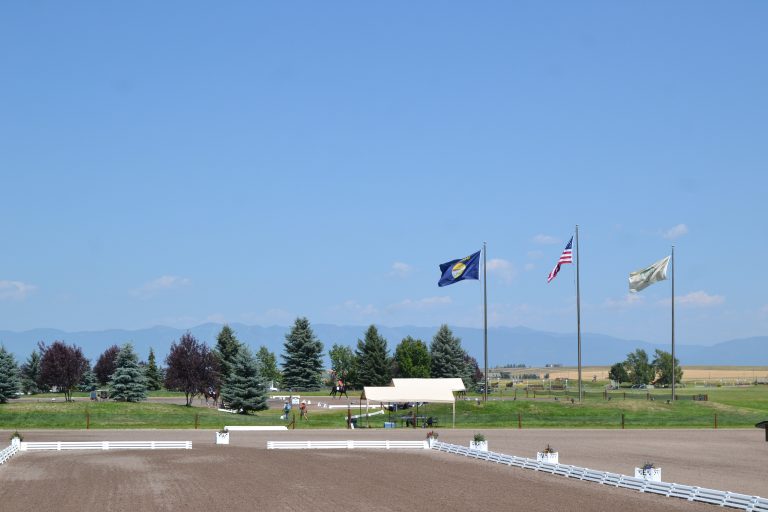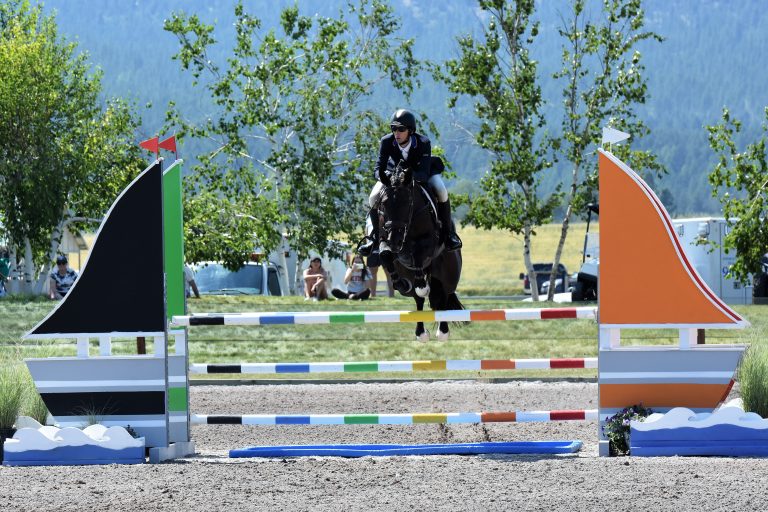
“If you build it, they will come” was the guiding mantra as the Broussard family first set to work developing Rebecca Farm. When they purchased 640 acres of Kalispell, Montana farmland in 2000, it was a blank canvas ripe for possibility: a true field of dreams, carpeted in bright-green billowing grass and framed by lavender mountains, the most distant of them capped in snow year-round.
Originally from Louisiana, Jerome and the late Rebecca Broussard, who passed away from breast cancer in 2010, moved to northwest Montana in the mid-1980s, drawn by its warm Western ambiance, spirit of independence and rugged beauty. The area they settled in, Flathead Valley, is a gateway to Glacier National Park and its residents tend toward strong connections to the natural world—horses included.
In the valley there was a small but passionate eventing community, the heart of which was based at Herron Park, a public park enjoyed by the locals—horseback riders, bicyclists, dog walkers and other outdoor enthusiasts. Rebecca, or “Becky” as she was known to her many friends, became deeply involved with the park, which regularly hosted U.S. Eventing Association-recognized horse trials. But it was a county park, inhibited by various restrictions, and its beloved Herron Park Horse Trials was fast outgrowing the venue. Always a visionary, Becky began the search for a space wide-open enough to allow her dreams for Big Sky Country eventing to grow.
“My mom wanted to create a world-class event on the West Coast and knew that wasn’t possible at Herron Park, so she and my father started to look at property in Kalispell,” says her daughter Sarah, a keen and accomplished rider herself. The Broussards were able to stitch together a few different parcels of land in Kalispell, near their home, and Rebecca Farm was born.
Despite its close-knit eventing community, northwest Montana is hardly an epicenter of the sport. The effort the Broussards put into the creation of an event that is hundreds, even thousands, of miles away from most riders may have seemed crazy from the outside looking in. But Becky’s enthusiasm for the project was infectious, and since then her legacy has lived on in incredible ways that perhaps even she might not have imagined possible.
And Then They Came
Barns, arenas and cross-country courses through Intermediate level emerged from the initial flurry of construction. By 2002 the venue was event-ready, and the first edition of the Event at Rebecca Farm attracted some 200 local and regional competitors.
In the following years, that number steadily rose as word got out about the venue with its crystalline summer skies, imaginative courses, sparkling competitor parties and free-spirited aura. The Broussards’ hospitality is second to none; they blur the line between horse show and holiday, welcoming competitors to the farm as though they were guests in their own home.
By 2010, in addition to horse trials, Rebecca Farm was offering two- and three-star FEI level divisions, a huge benefit to West Coast riders with limited access to upper-level events. To help facilitate participation from the country’s top riders, the Broussards offered generous travel grants and even flew select East Coast horses to the venue via a charter airplane dubbed “Air Horse One.”
With Novice through Intermediate horse trials, USEA Young Event Horse and Future Event Horse qualifiers and classic-format Training and Preliminary Three-Day Events on the menu, running simultaneously with the FEI divisions at the annual event, Rebecca Farm has something special to offer competitors of all levels. This year’s event, held July 19–23, attracted about 650 riders, some of them driving a full two days across the country to get there.
Team USA veteran Bruce (“Buck”) Davidson, Jr., is one rider who has made multiple treks to Rebecca Farm over the years from his summer base in Pennsylvania. In 2010 his ride My Boy Bobby, with whom he finished second in the CIC***, was among a historic flight of 18 horses from the East Coast organized by Becky. Other years his rides have arrived “by bus,” including last year, when he won the CCI*** with Copper Beach and the CCI** with Halimey.
“I’ve been very fortunate to have some really good owners who see what the Broussards do for the sport and they want to get behind that and support what they’re doing,” Buck says. “It’s a great venue and the Broussards do so much, so if I can do my small part to help eventing in this country then I try to do it. We’re lucky to be able to come here.”
Erin Sylvester, who won this year’s CCI*** with Paddy the Caddy, was one of 16 riders awarded a USEA Foundation Rebecca Farm travel grant this year. She says the funding helped offset the costs of her and her horse’s journey from Pennsylvania to Montana, making their maiden voyage to the event feasible.
“Rebecca is even better than everyone describes it,” she says. “The effort that they put into going above and beyond for riders, spectators and owners is really special. Every event has its ‘thing’ they drive home, and Rebecca tries to nail it and make it an amazing experience.”
The trek can be long even for West Coast competitors, many of whom return each year. It’s a solid 24-hour drive for Tamra Smith of Temecula, California, who won the CIC*** this year with Fleeceworks Royal, but as usual she showed up to support the event with multiple horses and students in tow. “The changes every year are huge, and just when you think it can’t get any better, it always does,” she says. “Leave it to Sarah and Jerome to make it that much better every time. It’s a special event.”
The Disneyland of Cross-Country Courses
The signature centerpiece of any event venue is its cross-country course. Rebecca Farm’s track is unlike any other in the world, a technical yet artistic gauntlet of questions designed to challenge and showcase the bravery and athleticism of those who tackle it.
To bring the course to life, the Broussards turned to experienced four-star designer Capt. Mark Phillips. Sarah says, “Mark Phillips was very instrumental in the beginning. He created the vision for the course.”
In 2012 organizers wanted to give the course a fresh feel. They brought on another legendary course designer and former Olympian, Ian Stark, for the task. “It’s such a beautiful place and it’s got a lot of scope for me to let my imagination run riot,” Ian says in his lilting Scottish accent.
It’s been called the “Disneyland of Cross- Country Courses,” with Ian playing the role of Walt Disney and builder Bert Wood and his dream factory working to bring Ian’s imaginings to fruition. Each jump is a work of art, creatively designed and decorated.
From jumps inspired by Montana’s landscape and wildlife to a miniature Wild West village to a Jurassic Park-themed vignette, the course is a roller-coaster ride that is entertaining just to walk, much less ride. Several variations on a theme appear year after year, like the bayou water complex that is a nod to the Broussard’s former home in Louisiana. Horses jump logs carved into giant crawfish, beavers, water moccasins and alligators, as well as Canada’s own Loch Ness monster, Ogopogo. Rebecca Farm’s course decor, clearly, is not for the faint of heart.
Ian is known for his bold galloping courses, and Rebecca Farm is no exception. His tracks reward attacking riding and a forward step. Long gallop stretches snake their way through vivid green soybean fields, allowing horses to re-establish rhythm and momentum between more technical combinations. “If riders come out of the start box feeling positive, it usually works out OK,” he says. “I don’t want horses to come out and be confused or off-put. I want them to come here and finish the course with confidence.”
The community shows up in droves on cross-country day, setting up chairs and blankets on a big hill overlooking a large, exciting water complex and much of the course. Last year’s event drew more than 10,000 spectators.
“The viewing is spectacular,” Ian says. Spectators can choose their own adventure, whether it’s sitting back and watching while enjoying a picnic or pressing up against the galloping lanes, so close that they can hear the horses’ hooves pounding turf as they thunder past. “Everyone watching can see nearly all the track from the top of the hill, but there’s nothing quite like getting the horses close to the spectators so they can see these incredible animals galloping and jumping right in front of them.”
Ian is constantly seeking new ways to strike a balance between spectator engagement and athlete experience. He understands what the event means to the community and wants to keep them coming back for more, year after year.
“The crowds here are amazing,” he says. “There are masses of people on the hill, streaming in all the time. The locals really get behind the event, which is brilliant.”
It Takes a Community
The Event at Rebecca Farm isn’t just some niche spectacle tucked away in the countryside. It’s a true community gathering, with free admission and a family-friendly atmosphere. For the youngsters, there is a Kid Zone with pony rides, face painting, arts and crafts, bounce houses and horsemanship 101 classes. Adults can run a 5K, enjoy a local craft brew and food truck fare or shop in the multi-interest trade fair.
“They say it takes a village, but we changed it a bit and say it takes a community,” Sarah says. “Really, this event would not be possible without their support.”
Local community involvement was always close to Becky’s heart. In addition to her prolific activity in the equestrian realm, she was involved in the Flathead Festival, Glacier Chorale Symphony, Backcountry Horsemen, Human Therapy on Horseback and Whitefish Winter Classic. She established a million-dollar scholarship fund at the Flathead Valley Community College and was a beloved supporter of dozens of local charities, such as Shepherd’s Hand and the United Way.
In turn, the community has embraced Becky’s dream of hosting an international event in their backyard, and it’s a synergistic relationship. Last year’s event returned $5.5 million to the local economy.
“I think that over the last 16 years the community has started to realize that this is more than just a horse show over in the west valley,” Sarah says. “What we have created here is definitely a boon for the economy. We bring in 650 horses and 650 riders and all their entourages, and they are going out into the community for lodging, food and necessities.”
Some of the jump judges and volunteers have been helping out at the event since the days of Herron Park. “They want to continue their support of their event. They’re quite proud and they take some ownership of it. They want to see it succeed,” Sarah explains.
The local eventing community is a beneficiary as well. Jil Walton, who was the highest-placed U.S. eventer at the 1992 Olympics in Barcelona, moved to Kalispell from California in 2006 and has witnessed Rebecca Farm’s ripple effect firsthand.
“It’s gotten bigger and bigger and more professional,” she says. “Its place on the calendar and the location and the big-time way it’s run make it a real destination event. And there are so many other things to do here, there’s something for everyone.”
It’s not uncommon for riders and their families to stick around after the event to visit Glacier National Park or for dads and husbands to sneak off on dressage day to do some fishing on Flathead Lake.
Jil hosts prep camps before the event and had 20 horses and riders contesting this year’s competition, from Novice through the three-star level. “It’s a big deal,” she says. “It gets everybody very motivated.”
Halt Cancer at X
The eventing community at large mourned the passing of Becky in 2010, following a battle with breast cancer. Seeking a way to honor her mother, Sarah founded Halt Cancer at X in her memory. In the years since, the initiative has raised and contributed over $250,000 to national cancer research and local support services for cancer.
“After my mom died, I came up with this idea that I felt would get a lot of support because my mother was so beloved by eventing and the community,” Sarah says. “And everyone has some connection to breast cancer: a mother, a sister, a daughter, a grandmother, a friend. It has no bounds.”
When the initiative launched it was largely dependent on pledges and donations but has since adopted a more diversified approach. Today there’s a place for everyone to participate during the July event, whether it’s contesting the Rebecca Farm to Market 5K Fun Run, making a $10 parking donation or bidding in a silent auction.
The Halt Cancer at X Challenge, featuring slightly rusty celebrity eventers, has become a big crowd-pleaser. This year, representatives from the USEA, USEF and Rebecca Farm faced off in a wildly entertaining, superhero-costumed mini-event held after each day’s competition.
Admittedly, the rules were a bit hazy: It’s a three-phase eventing competition—that much is clear—but in this case it was more of an interactive sport. Spectators’ on-the-spot donations went toward coercing the competitors into completing tasks (removing one’s shirt during the dressage test, for instance) or adding/subtracting points from their score.
“It’s taken on a life of its own,” says Sarah, who helped lead Team Rebecca to victory in this year’s challenge. Dressed as Wonder Woman, she and Bert “Thor” Wood were the only pair that didn’t take a spill cross country and their final show- jumping trick was jumping the awards podium. “We’re just out there having fun.”
“Halt Cancer at X continues to be very successful,” Sarah says. “I’m awed by the whole thing and the way people have come together to support it.”
Becky’s spirit permeates Rebecca Farm, especially during the one week in July each year when eventers and eventing enthusiasts from around the country flock there to revel in the sport they love. And for the Broussard family and those who knew Becky, the event is more than a competition—it’s a celebration of her life.
“When you talk about communities that support us, I would be remiss if I didn’t mention our ‘Rebecca Farm family’ that includes the people here who make the event run as well as actual family members,” Sarah says.
From immediate and extended family to her parents’ high-school friends, the event is a gathering place for the Broussards’ dearest connections. It’s yet another way that Becky’s “if you build it, they will come” prophecy has played out at Rebecca Farm.
“The family has really come together to support this—it’s almost like a family reunion for us, too,” Sarah says. “They’re invested in this project that my mother created, and we take it very seriously. It’s very close to our hearts.”
An NAJYRC to Remember

This July, competitor Buck Davidson attended the Event at Rebecca Farm in a different capacity as the Area I one-star team coach for the North American Junior & Young Rider Championships, which Rebecca Farm hosted in conjunction with its annual horse trials.
Over 50 NAJYRC competitors from every corner of the U.S. and Canada made the trip to Rebecca Farm, many of whom might never compete there otherwise. “It’s exciting to see the number of NAJYRC competitors on par with previous years and proves that Montana truly is a bucket-list destination for many riders near and far,” says organizer Sarah Broussard. She says she was grateful for the opportunity to host the championships, furthering her mother’s ardor for assisting young riders on their path to contesting the upper levels of the sport and representing their country in international competition.
“It’s something I’ve wanted to do but for one reason or another it never happened,” she says. Historically, all the NAJYRC disciplines have competed at the same large venue, such as the Kentucky Horse Park or the Colorado Horse Park. This year, for logistical reasons, eventing splintered off from the pack and needed a new home. “Eventing was sort of the orphan child, and I said ‘Oh yes, of course we’ll host it,’” Sarah says.
Sarah, a former NAJYRC competitor herself, knows firsthand what a benchmark the championships can be in the lives and careers of aspiring eventers. “The experience was about so much more than just riding,” she says. “Nothing beats the rush of excitement while on course and that incredible feeling of support one gets from both your team and those watching. It is an honor to help facilitate that experience for the next generation of young riders.”
This year’s NAJYRC teams exercised creativity and determination in their fundraising efforts to offset travel expenses to Montana. From silent auctions and GoFundMe campaigns to pancake breakfasts and benefit horse trials, the riders made it happen and went home with glowing reports from their experience.
NAJYRC two-star team gold and individual silver and bronze medalist Cornelia Dorr traveled to Rebecca Farm from Massachusetts—a 2,600-mile journey. “It was pretty daunting, packing and putting it all together,” she says. “But it’s not so bad once you have it figured out.”
William Zuschlag, from South Carolina, won the NAJYRC individual gold. “The trip was definitely more doable than I thought it would be,” he says.
This article was originally published in the October 2017 issue of Practical Horseman.










